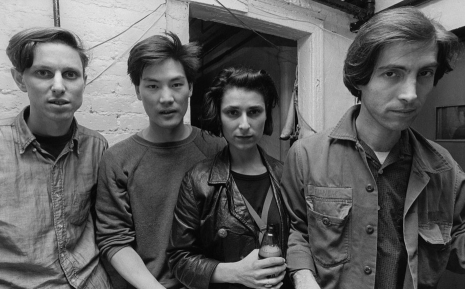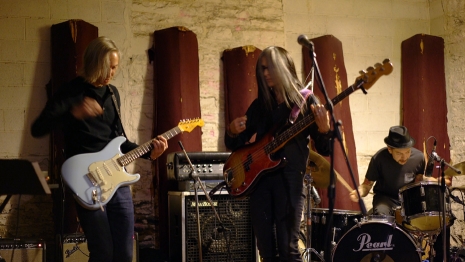
The New York noise scene that emerged with and after No-Wave can feel like the story of Sonic Youth and its near-orbit, due to that band’s massive influence. But Downtown artnoise can as easily be understood by viewing Martin Bisi as a nexus. Far from a household name, Bisi is a producer you know if you’re a liner note studier who listens to SY, Swans, John Zorn, Foetus, Material, Cop Shoot Cop, and plenty of others in the worlds of hip-hop, weird jazz, and weird rock, though surely his best-known production among civilians is Herbie Hancock’s utterly game-changing “Rockit.” The documentary film Sound and Chaos: The Story of BC Studio details Bisi’s trajectory, and we recommend it unconditionally to all who have an interest in that scene.
In early 2016, his Gowanus, Brooklyn studio, sort-of eponymously named “BC,” had been in operation for 35 years, and to commemorate the milestone, a weekend-long series of performances took place in the facility. It included newly composed and improvised pieces by the noise-mongers that had made their signature works there, including members of Sonic Youth, Foetus, Pop. 1280, Dresden Dolls, and Alice Donut. Most excitingly, it featured a band called “New Old Skull,” a reunion, after almost 30 years of inactivity, of members of the seminal New York noise guitar band Live Skull.
100% of a piece with their better-known contemporaries, Live Skull conjured a massively discordant squall of guitars and a creepy, desperate vibe. The band was formed by guitarists Mark C and Tom Paine, and by the time they’d become a recording concern, it included bassist Marnie Greenholz (now Jaffe) and drummer James Lo. They released eight LPs and EPs of menacing but hypnotic artnoise between 1984’s self-titled debut EP and 1989’s Positraction, by which time they’d added singer Thalia Zedek and replaced the departed Lo and Greenholz with Ruin’s Richard Hutchins and Rat At Rat R’s Sonda Andersson, respectively.
Though they never made as big of a splash as Sonic Youth (who from that scene did?), they were as well-regarded in their time: amazingly, they were the subject—along with SY, Swans, and Rat At Rat R—of a feature in the normally rather conservative Guitar Player magazine in 1986, and they were included on the crucial Speed Trials compilation, an album that also introduced the world outside Downtown NYC to a band called The Beastie Boys. After their split, Zedek made big waves with her ‘90s band Come, and Lo joined the marvelous noisy indie rock ensemble Chavez.

New Old Skull will be performing at St. Vitus Bar in Brooklyn in April as part of a showcase celebrating the release of BC 35, the recorded document of Bisi’s anniversary performances, with more shows to follow in Philadelphia and Boston in early May (the Boston show will bring Zedek back into the fold). They’ve made a video of their BC 35 song “Details of the Madness,” and in addition to premiering it for you today, Dangerous Minds chatted with Mark C about the reunion, the ’80 NYC avant-noise scene, and Martin Bisi’s contributions to it.
Dangerous Minds: So who all is in New Old Skull? I don’t see Thalia Zedek in the video…?
Mark C: For that song, which was based on the live recording we did at Martin’s 35 anniversary at his studio, it’s Rich Hutchins, Marnie Jaffe, the original bass player, and me, just the three of us. And so far that’s the project, just the three of us, though we’ll be playing with Thalia when we play live coming up.
DM: Will there be more new music going forward or is this it?
MC: We’re taking it as it comes, there’s no real master plan, but having gotten together a few times, we now have a small body of material that I’m sure we’ll at least try to record, four or five pieces so far. We’ve been enjoying getting together and liking the way it fits together. It seems to work out between us pretty easily. Initially we were focused on just doing that one show, and then the record was coming out so they decided to do another show. We hadn’t even run into each other since the Bisi anniversary party, and then when we heard there was going to be a record release party we got back together to start playing again. So far we’ve been excited about the results. We haven’t done any Live Skull material at all, everything was written for the show.
DM: Why the name change?
MC: Tom Paine and I were partners at the beginning of Live Skull—Marnie was there too, but Tom and I had worked together before, and he was with me all the way through the band, so I felt like in order to call it “Live Skull” he’d have to be in it. And also, this was just going to be one night, so when we decided to do new material, we decided to use a new name. I’ve been involved in Live Skull because we’ve been re-releasing the albums on a French label, and I’ve been in contact with Tom and other members through that process, and being in the thick of that, what Rich, Marnie and I were doing felt like something different. And the name—there was a band called “Old Skull”…
DM: Yeah! I was gonna say!
MC: It’s true, we kind of borrowed it. We were always kind of fascinated by them back in the day, because they were basically the young children of punk musicians.
DM: I’ve heard there’s kind of a sad story behind all that. Not that anyone knew it at the time.
MC: I guess so. I’ve heard bits and pieces of that, but that wasn’t what was on our minds. We just picked the name in the spur of the moment to distinguish it from Live Skull. None of us really want to go back in time.
DM: OK, so let me take you back in time.
MC: [laughs] OK!
DM: I’d like to know your impressions of the New York noise scene back then, you guys, Swans, Sonic Youth—Martin Bisi obviously was right in the center of it all. How did he become the go-to guy?
MC: One thing we noticed and talked about in New York at that time was even though bands would be very focused on whatever sound they were mining, the scene overall was very eclectic, dance music was happening in the same clubs as punk. Madonna could be upstairs and Live Skull could be downstairs at Danceteria on the same night and people would pay the same admission to go see either one. Not saying that specifically happened, just that it was the sort of thing that could happen all the time. While Live Skull were trying to be a heavy noise post-punk band, Tom and I were also DJing after hours at dance clubs. Now, there were Live Skull fans who’d never come to the dance party, and there were late night club kids that would never come see Live Skull, but there were a lot of Downtown New Yorkers who were excited by everything that was going on, excited by the energy and creativity, it wasn’t so locked in to one specific thing.
Martin was someone who totally understood that. We loved the production that was happening at the time, including rap production, and when we found out about Martin, and the fact that he was working with Herbie Hancock and others, it seemed like he could do cleaner production. We didn’t want to do another hard-to-listen-to punk 45, as much as I relish them, that wasn’t our goal, we wanted a sound that was a little more comprehensive, we wanted it to sound more classic in terms of production. But we didn’t know anything about production at the time, so we were lucky to have Martin, he was doing great. I think Sonic Youth were the first to go there to record, so we may have heard about him through them. Our first E.P. was recorded upstairs at Radio City, they had a studio, I think that’s where the Ramones did their first record, and the first thing we did with Martin was mixing our first full length album—I think, now I’m wondering!—and our third record and all the others were recorded and mixed with Martin. We knew, and were happy, that he was not just strictly a punk producer, but of course we also knew he was working with other post-punk bands, and you could tell, working with him at the studio, that he had the right outlook. The studio was one room, you played right there in the room with him, there wasn’t separation. And we played live, which was our intent at the time, to capture the live sound. It’s only later we learned that you can make things sound live without being live [laughs], but we didn’t worry about that at the time, and Martin was very able and accommodating and didn’t get in our way at all.

New Old Skull at BC. Photo by Jennifer Jaffe
While we had him on the hook, we asked Mark to talk about “Details of the Madness” in particular:
MC: Live Skull’s existence coincided with Reagan’s presidency, and our current situation is a similar feeling—the night Reagan got elected, we had just moved to New York, and I’ve never seen New York darker or quieter or more depressed except for 9/11. I feel like we had to scream out, you had to express yourself so you don’t go crazy, and now, there’s some of the similar feelings. The world’s changed so much it can’t really be the same thing, but “Details of the Madness” is that same exasperation. The lyrics are like “We believe in revolution” et cetera but it’s really a metaphor for wanting to scream out in the same way as we did back when we started, the song is about feeling like the world is off. When I grew up, when I was in grade school, the Vietnam War was going on, and once we got past that, I felt like the world would enter a steady enlightenment period. We’d been through the Civil Rights Movement, and then we got to the other side of that war and realized that it was wrong, so we should keep progressing towards enlightenment, and the fact that we keep having these major setbacks is what “Details of the Madness” is about.
Previously on Dangerous Minds:
Sonic Youth and Mike Watt vs Madonna
‘90s underground rock guitar kings Chavez return after 20 years
Never before seen footage of Swans in concert; A DM exclusive premiere
Never too young to rock ‘n’ roll: The third grade punk of Old Skull